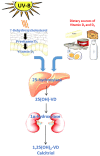Vitamin D and Infectious Diseases: Simple Bystander or Contributing Factor?
- PMID: 28672783
- PMCID: PMC5537771
- DOI: 10.3390/nu9070651
Vitamin D and Infectious Diseases: Simple Bystander or Contributing Factor?
Abstract
Vitamin D (VD) is a fat-soluble steroid essential for life in higher animals. It is technically a pro-hormone present in few food types and produced endogenously in the skin by a photochemical reaction. In recent decades, several studies have suggested that VD contributes to diverse processes extending far beyond mineral homeostasis. The machinery for VD production and its receptor have been reported in multiple tissues, where they have a pivotal role in modulating the immune system. Similarly, vitamin D deficiency (VDD) has been in the spotlight as a major global public healthcare burden. VDD is highly prevalent throughout different regions of the world, including tropical and subtropical countries. Moreover, VDD may affect host immunity leading to an increased incidence and severity of several infectious diseases. In this review, we discuss new insights on VD physiology as well as the relationship between VD status and various infectious diseases such as tuberculosis, respiratory tract infections, human immunodeficiency virus, fungal infections and sepsis. Finally, we critically review the latest evidence on VD monitoring and supplementation in the setting of infectious diseases.
Keywords: HIV/AIDS; fungal infections; infectious diseases; oxidative stress; sepsis; tuberculosis; vitamin D; vitamin D deficiency.
Conflict of interest statement
The authors declare no conflict of interest.
Figures




Similar articles
-
Vitamin D Deficiency in Chronic Kidney Disease: Recent Evidence and Controversies.Int J Environ Res Public Health. 2018 Aug 17;15(8):1773. doi: 10.3390/ijerph15081773. Int J Environ Res Public Health. 2018. PMID: 30126163 Free PMC article. Review.
-
Applications of vitamin D in sepsis prevention.Discov Med. 2018 Jun;25(140):291-297. Discov Med. 2018. PMID: 30021102 Review.
-
The potential role of vitamin D for prevention and treatment of tuberculosis and infectious diseases.Ann Ist Super Sanita. 2012;48(3):319-27. doi: 10.4415/ANN_12_03_13. Ann Ist Super Sanita. 2012. PMID: 23007057 Review.
-
Evaluation of vitamin D prophylaxis in 3-36-month-old infants and children.J Pediatr Endocrinol Metab. 2017 May 1;30(5):543-549. doi: 10.1515/jpem-2016-0223. J Pediatr Endocrinol Metab. 2017. PMID: 28328529
-
Air pollution, environmental chemicals, and smoking may trigger vitamin D deficiency: Evidence and potential mechanisms.Environ Int. 2019 Jan;122:67-90. doi: 10.1016/j.envint.2018.11.052. Epub 2018 Nov 30. Environ Int. 2019. PMID: 30509511 Review.
Cited by
-
Notable Developments for Vitamin D Amid the COVID-19 Pandemic, but Caution Warranted Overall: A Narrative Review.Nutrients. 2021 Feb 26;13(3):740. doi: 10.3390/nu13030740. Nutrients. 2021. PMID: 33652653 Free PMC article. Review.
-
Sunlight exposure, consumption of vitamin D-rich foods and vulvovaginal candidiasis in an African population: a prevalence case-control study.Eur J Clin Nutr. 2020 Mar;74(3):518-526. doi: 10.1038/s41430-019-0517-7. Epub 2019 Oct 21. Eur J Clin Nutr. 2020. PMID: 31636409
-
The Potential Role of Vitamin D in the Development of Tuberculosis in Chinese Han Population: One Case-Control Study.Front Med (Lausanne). 2022 Jul 25;9:849651. doi: 10.3389/fmed.2022.849651. eCollection 2022. Front Med (Lausanne). 2022. PMID: 35957850 Free PMC article.
-
Artesunate interacts with the vitamin D receptor to reverse sepsis-induced immunosuppression in a mouse model via enhancing autophagy.Br J Pharmacol. 2020 Sep;177(18):4147-4165. doi: 10.1111/bph.15158. Epub 2020 Jul 6. Br J Pharmacol. 2020. PMID: 32520399 Free PMC article.
-
Variations of Serum Oxidative Stress Biomarkers under First-Line Antituberculosis Treatment: A Pilot Study.J Pers Med. 2021 Feb 9;11(2):112. doi: 10.3390/jpm11020112. J Pers Med. 2021. PMID: 33572362 Free PMC article.
References
-
- Vitamin D. The British Dietetic Association (BDA) Food Fact Sheet. [(accessed on 31 March 2017)]; Available online: https://www.bda.uk.com/foodfacts/VitaminD.pdf.
Publication types
MeSH terms
Substances
LinkOut - more resources
Full Text Sources
Other Literature Sources
Medical

